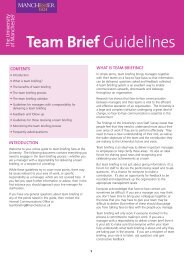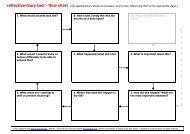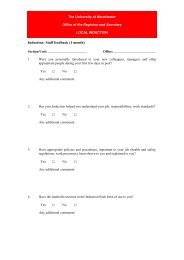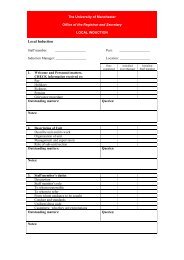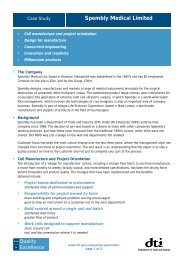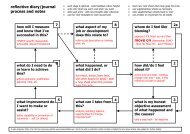Workforce Management: Age Positive Guide - Employers
Workforce Management: Age Positive Guide - Employers
Workforce Management: Age Positive Guide - Employers
- No tags were found...
Create successful ePaper yourself
Turn your PDF publications into a flip-book with our unique Google optimized e-Paper software.
<strong>Workforce</strong> <strong>Management</strong>:<strong>Age</strong> <strong>Positive</strong> <strong>Guide</strong>
IntroductionIt has been shown that employing an age diverse workforce can have realbenefits for your organisation. People of all ages have the potential to contributepositively to your business at every level as long as the workforce is managedpositively and fairly.We understand that often, many small businesses don’t have a dedicated HRresource, but hope that this leaflet will provide some tips and help for employersof all sizes.This leaflet is not intended to cover all individual circumstances, provide in-depthadvice and will not guarantee any level of compliance with legislation. However, it willgive you a range of examples of how other – small, medium and large – organisationsare realising their potential through the way they manage their workforce.<strong>Age</strong> LegislationFrom 1 October 2006 the EmploymentEquality (<strong>Age</strong>) Regulations make it unlawful todiscriminate against employees, job seekersand trainees on the grounds of age.The regulations cover workers of all ages –young and old – and all employment andvocational training. This includes all workforcemanagement processes including: access tohelp and guidance, recruitment, training,promotion, pay, benefits and particularlyretirement and redundancy.What this means for youSimply put, the new regulations mean thatyou need to:• look at the way you manage and monitoryour workforce and• check that any policies, practices orroutines you operate are age compliant.Specifically, you should ensure that:• you understand the age make-up of yourworkforce and use this information toidentify potential workforce issues relatingto age• take positive action to offset any futurestaffing crises (for example if a largenumber of your staff are due to retire at thesame time)• make sure everyone is being treatedequally, regardless of his or her age• staff involved in workforce management arefully aware of their responsibility not todiscriminate on the basis of age or othergrounds• there are routines or practices in place tocheck that no bias, deliberate orunintentional, influences any managementdecisions.<strong>Workforce</strong> <strong>Management</strong>: <strong>Age</strong> <strong>Positive</strong> <strong>Guide</strong> 1
Business benefits of agepositive workforcemanagementYou already know that an effective,motivated workforce is key to businesssuccess. It therefore goes without sayingthat balancing the needs of your employees(of all ages) with what your organisationneeds to succeed improves your chancesof beating the competition.This means keeping an eye on what ishappening with your staff – not only checkingon the number and type of people you arehiring, promoting, retiring etc, but alsomaking sure your existing staff are beingmanaged fairly and equally.Check your policies and practices to makesure they are age-proofed – check if trainingis available to all staff, are staff aware ofworking hours policies, flexible options,sickness, parental and carers policies? Plus,have you checked that your pay and benefitawards are not age related? Knowing all thisenables you to take positive action whereproblems arise.Recruitment is a key area. How often areyou recruiting new staff? Is this becauseyou have a high turnover? Remember, everytime you recruit you are incurring a cost.The Chartered Institute for Personnel andDevelopment (CIPD) estimates that it costs anaverage of £3,600 to recruit each employee –this may be less for unskilled posts or more(up to £8,000) for more senior positions. 1So to keep costs to a minimum, keep a closeeye on who applies, who you recruit and,if you have high turnover, in which areasor department this occurs.Similarly, by monitoring the training anddevelopment opportunities taken up by eachof your employees, and making sure thateveryone is treated fairly regardless of theirage, you will help staff feel valued andmotivated to contribute to the success ofthe organisation. In the same way, offeringa range of flexible working options that areappropriate to the age profile of your staffmakes for a more adaptable and moreproductive workforce.Nationwide’s recent staff survey showedvery high levels of satisfaction, with 80per cent of staff agreeing with thestatement, ‘I believe that developmentopportunities are equal for all employeesregardless of age.’ 2Many employers have enjoyed significantbenefits as a result of adopting this type ofage positive approach to workforcemanagement.For example, it’s a fact that effectivelymanaged older workers have been shownto have better attendance and stay in the jobfor longer.<strong>Positive</strong> Contact, an outsource callcentre, have benefited from very lowstaff turn-over rates – just six per cent in2005, compared to a national sectoraverage of 22 per cent. They attributethis in large part to their diversitypolicies.There are a wide range of other benefits thatmany employers are not taking full advantageof. For instance, some younger workers aremore conversant with the more technicalaspects of IT and can be encouraged tomentor older workers, while older workers canbe encouraged to share new skills and ideaslearned in previous employment or relatedcareers.1www.cipd.co.uk. Annual Survey Report 2006: Recruitment, Retentionand Turnover2<strong>Employers</strong> Forum on <strong>Age</strong> Diversity Case Studies.www.efa-agediversity.org.uk/case-studies/nationwide.htm2<strong>Workforce</strong> <strong>Management</strong>: <strong>Age</strong> <strong>Positive</strong> <strong>Guide</strong>
Wheelies Direct (a cycling insurancereplacement service) have noticed thattheir older employees are not only veryreliable and loyal to the company, theyalso bring a wealth of skills to theworkplace. Their well-developed customerservice skills, for example, set a goodexample to less experienced colleagues.As a result, these older workers havebecome valued mentors and role models.And last, but by no means least, a properlymanaged age diverse workforce can help youprovide a better service to your customers,with obvious benefits to your business.The Scottish Court Service realised thatby employing staff of all ages, withdifferent attitudes, opinions andexperiences, they are better able tounderstand the needs of their customers.They have received positive feedbackfrom both older and younger customerswho were extremely grateful to find amember of staff they felt comfortabletalking to.Domestic & GeneralWho we areDomestic & General’s main business isproviding warranty protection fordomestic appliances. We employ 1,300staff across three main call centre sites –in Nottingham, Brighton and Slough.What we do<strong>Management</strong> at our Nottingham call centrehas long been convinced of the businessbenefits of employing an age diverseworkforce. We monitor and enforce ourage positive approach in a number ofways:• we are careful to make sure the agemake-up of our workforce closelyreflects that of the local population• all external recruitment agencies weuse attend our internal age briefings• all advertised posts, whether internal orexternal, are monitored in terms of the‘type’ (including age) of people applying– with follow-up work to find out whatthey thought of the job advert to makesure it does not discourage anyparticular groups• we conduct exit interviews with allleavers, including questions on whetherpeople have felt discriminated againstand on what grounds. These findingsare collated and fed back to seniormanagement, as well as the relevantline manager and department, on aregular (monthly or quarterly) basis.How it has benefited our business• our older staff are very understandingof the types of problems our typicalcustomers experience, which improvesthe service we are able to provide• employing an older workforce has ledto lower levels of absenteeism• our training department tell us thatolder recruits on our induction trainingtend to get things right the first timemore often than younger trainees –plus, they are very keen to learn• feedback from our younger staff showsthat they benefit a great deal from thecoaching that older workers are ableto offer.<strong>Workforce</strong> <strong>Management</strong>: <strong>Age</strong> <strong>Positive</strong> <strong>Guide</strong> 3
Ensuring your workforce ismanaged in an age positive wayThe following checklist has been compiled frompractices adopted by employers who havealready reaped the benefits of an age positiveapproach to managing their workforce. This willhelp you evaluate the way you manage yourstaff and make any necessary changes.Managing your workforceNo-one is ‘too old’ or ‘too young’ – makesure all your policies – from recruitment totraining to flexible working to health andsafety – emphasise that age is not a barrierTalk to your employees regularly and askfor their views of their work, how they feelabout the organisation and the benefitsyou make available – this can be doneinformally, in a staff survey, or throughappraisals/performance review meetingsKnow your staff – keep a record of the ageof your employees at all levels and in alldepartments. This will help you to identifyany areas of concern (for example whereall employees are nearing retirement orwhere you need to recruit to fill expandingor critical areas)Compare the age profile of yourworkforce with that of the localpopulation to make sure you are recruitingfrom as wide a pool as possible – a usefulsource of local population data iswww.neighbourhood.statistics.gov.ukKeep a record of the number and type ofpeople being recruited. Count the numberof candidates in different age groups whoapply for each post and compare this withthe age of those being short-listed andhired – if any bias is detected, speak to themanager(s) involved to find out why andtaken action to stamp out.Check the age profile of staff that attenddifferent training courses and getfeedback from trainees. Look for anydifferences by age to make sure no groupis being discriminated against or neglectedMonitor unsuccessful promotioncandidates. Get feedback from theinterview panel to find out if any trainingneeds have been identified and also toensure no age bias has occurred in theselection process. Also talk to thecandidates, use the interview as anopportunity to discuss their careerprogression and identify any training orother needs they may haveUse agreed criteria (for example inrecruitment or promotion) to ensure allmanagement decisions are fair to allemployees. Base these on business andindividual need, as well as skills andperformance, and make sure that allcriteria are transparent to all staffIf you don’t have a dedicated HRdepartment, get a second opinion from acolleague to make sure your decisionsdon’t discriminate on the basis of ageUse exit interviews to identify any issuesor problems within your workplace. Checkthat individuals are not leaving due tounfair treatment or victimisation/harassmenton the grounds of age and, importantly,act on any justified complaintsThe business benefits of a motivatedworkforce include:Reduced recruitment costsImproved public imageImproved staff retention ratesLower turnover costsImproved productivityImproved mentoring capacity.Other good practiceNo matter what the size of your business,ensure you communicate your age positiveapproach to all your employees – talk to themface-to-face, discuss matters informally,and ask for comments. If you have a morestructured approach, use team meetings,in-house newsletters or your intranetDon’t just train those making businessand policy decisions in equality anddiversity – make sure line managers andthose dealing with employees on a dayto-daybasis get the benefit of training inthese issues as wellAn equality policy is one of the easiestways to demonstrate that you takediscrimination seriously. Considerincluding all forms of discrimination andharassment – gender, race, disability,gender reassignment, sexual orientation,religion and belief as well as age.4<strong>Workforce</strong> <strong>Management</strong>: <strong>Age</strong> <strong>Positive</strong> <strong>Guide</strong>
A changing workforce foremployersAll businesses should be aware that the UKlabour force is ageing. Currently, peopleaged 50+ represent:• almost 30 per cent of people of workingage 3 and• 26 per cent of those actually in work 4 .And by 2020 there will be nearly five millionmore people aged 50+ in the UK 3 . Most peopleare living not only longer, but also fitter andhealthier lives. For example, participants inthe 2007 London Marathon included 1,730competitors aged 60+ – three per cent of thetotal entry.This, combined with a declining birth rate andincreased skills shortages in many sectors,makes the need to take an age positiveapproach to workforce management morepressing than ever. And this will continue tobecome ever more important over the next10-15 years.Take, for example, the ‘Transport andLogistics’ sector, which covers all land, water,air and space transport and logistics, plussupporting activities like storage, warehousingand travel agencies. The sector currentlyemploys around 1.3 million people (four percent of the national workforce) across 64,000organisations. Although a relatively stablesector, by 2014 it will need an additional478,000 workers, to fill skills gaps and tomeet the gap left by retirement of acomparatively older workforce (17 per cent ofworkers are currently over 55). 5Newham CollegeWho we areNewham College of Further Education isbased in London and is one of the largestfurther education colleges both nationallyand in the Greater London Area.We offer a very wide range of learningopportunities throughout the Boroughand surrounding areas and aim to removeall barriers to education.What we doWhen it comes to managing our agediverse workforce we:• hold regular audits where we collectdata on all our staff, including age –we use this to inform our equalopportunities plan for the following year• monitor every stage of employment,for example the number and type ofapplicants, short-listed and successfulcandidates – if bias is identified at anystage, the manager(s) involved isretrained in Equal Opportunities• conduct impact assessments of all ournew practices and policies and reviewhow they will affect different agegroups (as well as gender, disability andother diversity strands).How it has benefited our organisation• we see a wide variety of applicants,making it easier to find the right personfor each job• we are able to overcome skill shortagesin many areas through successionplanning and transferring skills fromolder to younger employees• we have also been able to retain theessential skills of lecturers in hard to fillposts who might otherwise have retired• many of our staff stay with us for 20years or more.3Government Actuary Population Projections, 2004.4Labour Force Survey Dec-Feb 075Managing an ageing workforce in the ‘transport and logistics’ sector.A report for employers available to view at www agepositive.gov.uk<strong>Workforce</strong> <strong>Management</strong>: <strong>Age</strong> <strong>Positive</strong> <strong>Guide</strong> 5
<strong>Age</strong> <strong>Positive</strong> <strong>Workforce</strong><strong>Management</strong>: answersto your questions1. I thought the new age regulationsonly applied to people looking forwork. Does it cover those who arealready employed as well?Yes, the regulations do cover anyone who isapplying for work but they also cover thosewho already work for an organisation and,in some instances, people who have leftemployment.They also cover people of all ages from 16upwards, with the exception of members ofthe regular armed forces, full-time and parttimereservists and unpaid volunteers.2. I only employ a small number ofstaff – do the regulations still coverme?Yes, all employers, regardless of size.This includes providers of vocational training,trade unions, professional associations,employer organisations and trustees andmanagers of occupational pension schemes.3. I don’t have an Equality Policy, doI need one?Although the age regulations do not actuallyrequire you to have an Equality Policy or anappraisal or performance managementsystem, it is good practice and good businesssense for companies, large or small, to havethem in place.If you have an Equality Policy, check thatit has been updated to include age. Reviewpolicies and procedures for age bias, includingthose covering sick absence, leave andholidays, discipline and grievances, flexibleworking, IT usage, pay and benefits etc.It is also important to update all employeesabout the changes and to ensure that thosewho make decisions that affect others aretrained, for example, although it is importantfor those who deal with recruitment andselection, it is also important for managersand supervisors to be able to recognise anddeal with age related bullying, harassment orvictimisation.If you don’t have one, consider developing apolicy – your local ACAS or Business Linkshould be able to help out.4. Why do I need an appraisalsystem, especially if it’s not a legalrequirement?It is possible within small organisations todeal with performance on a one-to-one basis,talking to all employees regularly anddiscussing their career aspirations and futureplans, this is particularly important for olderworkers, who may feel left behind or who maynot be performing to their full capacity; orfor younger workers, who may feel you offerno progression or opportunities to train ordevelop.For a larger organisation, a good appraisal orreview system is important to manage staffdevelopment and ensure all staff feel valuedand remain productive and motivated.Additionally, with the increased importancein employing and retaining older workers, agood appraisal system provides managerswith an unbiased tool to address anyperformance problems and work outsolutions, for example, identifying trainingneeds, changing working hours to addresscaring needs or providing workplaceadjustments to address any work placehealth problems. This is always preferableto ignoring problems.6<strong>Workforce</strong> <strong>Management</strong>: <strong>Age</strong> <strong>Positive</strong> <strong>Guide</strong>
5. Will age be a factor in theinsurances that my businessprovides to employees as partof their benefits?Yes, health, sickness, life and other insurancepolicies are covered by the age regulations.Some (mainly large) employers provide theiremployees with Group Income Protection,Critical Illness and Life Insurance cover.Under the age regulations, care is neededwhere the cover is withdrawn or reduced, solelyon the basis of the age of the employee.The benefits provided are usually calculatedto cease at an age which aligns withemployees entitlement to companyoccupational pension, state pension or in linewith the default retirement age. Where anemployer agrees that an employee can worklonger than this, the benefits provided underthese schemes can only be withdrawn orreduced if it has been objectively justified.For further help on insurance issues, checkout Association of British Insurers websiteat www.abi.org.uk or the Group RiskDevelopment website at www.grouprisk.org.uk.6. What should I do to make sure mysystems are in accordance with theregulations?Review any policy or practice includingharassment, equality, and appraisal andperformance systems, to make sure thatthey include age, are working fairly and arewithout bias.Ensure you check for age related historicalpractices within your policies. Remember, ifthese are outside the five year exemptionperiod stipulated within the new regulationsthey could now be unlawful.Unacceptable behaviour is a serious issueand action will need to be taken if it occurs.Remember, what one person sees as a joke ora minor issue, another can feel very differentlyabout, for example, using inappropriatecomments or names such as ‘over the hill’granny, granddad, ‘wet behind the ears’, junioretc. Additionally, don’t permit ageist jokes orageist birthday cards, the same rules apply – itonly takes one person to find it offensive andyou could end up with a claim.These are important areas, if you haveconcerns, seek advice. If you don’t have accessto your own HR department or to independentlegal advice, ACAS is the nominated agencyto give advice and guidance on age issues.Contact their Helpline on 0845 7474747or go online at www.acas.org.ukGood practice, help and information is alsoavailable on the <strong>Age</strong> <strong>Positive</strong> website atwww.agepositive.gov.uk or look at any of theother sources of help and information listedin this leaflet.<strong>Workforce</strong> <strong>Management</strong>: <strong>Age</strong> <strong>Positive</strong> <strong>Guide</strong> 7
Sources of additionalinformationGeneral help and information<strong>Age</strong> <strong>Positive</strong>www.agepositive.gov.ukACAS08457 474 747www.acas.org.ukBusiness Link0845 600 9 066www.businesslink.gov.ukFinancial Services Authority0845 606 1234www.fsa.gov.ukBritish Chambers of Commerce (BCC)020 7654 5800www.chamberonline.co.uk<strong>Age</strong> Concern0800 00 99 66www.ageconcern.org.ukThe <strong>Employers</strong> Forum on <strong>Age</strong> (EFA)0845 456 24 95www.efa.org.ukTrades Union Congress (TUC)020 7636 4030www.tuc.org.ukConfederation of British Industry (CBI)020 7395 7400www.cbi.org.ukChartered Institute of Personnel andDevelopment (CIPD)020 8612 6200www.cipd.co.ukChartered <strong>Management</strong> Institute (CMI)01536 204 222www.managers.org.ukEqual Opportunities Commission (EOC)0845 601 59 01www.eoc.org.ukThe <strong>Age</strong> and Employment Network (TAEN)020 7843 1590www.taen.org.ukRecruitment and Employment Confederation(REC)www.rec.uk.comFederation of Small Businesses (FSB)020 7592 8100www.fsb.org.ukAssociation of British Insurerswww.abi.org.uk0207 600 3333British Insurance Brokers Association (BIBA)www.biba.org.uk091 814 0015Group Risk Development (GriD)www.grouprisk.org.ukOther Government sitesDepartment of Trade and Industry (DTI)www.dti.gov.ukDepartment for Work and Pensions (DWP)www.dwp.gov.ukHM Revenue and Customs (HMRC)www.hmrc.gov.ukHealth and Safety Executive (HSE)www.hse.gov.ukDirectgov (Employment)www.direct.gov.uk/en/Employment/8<strong>Workforce</strong> <strong>Management</strong>: <strong>Age</strong> <strong>Positive</strong> <strong>Guide</strong>
Copies of this publication can be downloaded fromwww.agepositive.gov.ukIf you require further copies, please e-mail: agepositive@dwp.gsi.gov.ukPlease quote ref: AP-workforce management – VO62007© Crown Copyright 2007Produced for <strong>Age</strong> <strong>Positive</strong>, Department for Work and Pensions by Ipsos Mori.Extracts from this document may be reproduced for non-commercial educationor training purposes on condition that the source is acknowledged.



